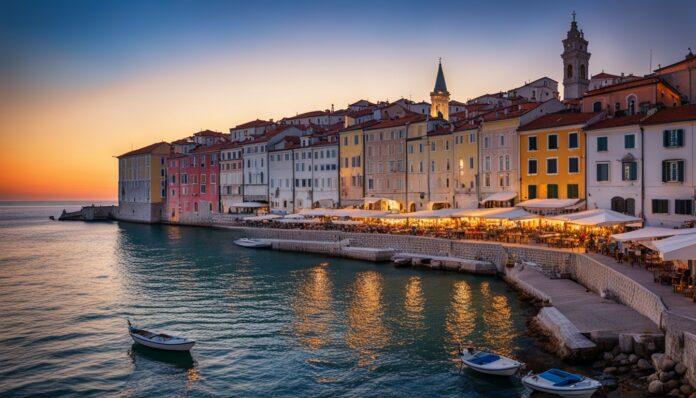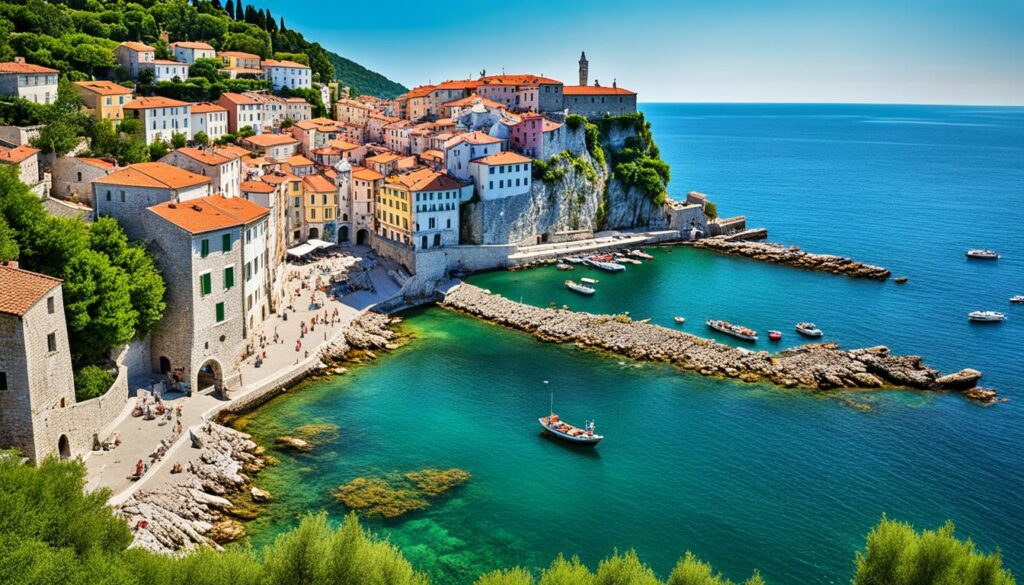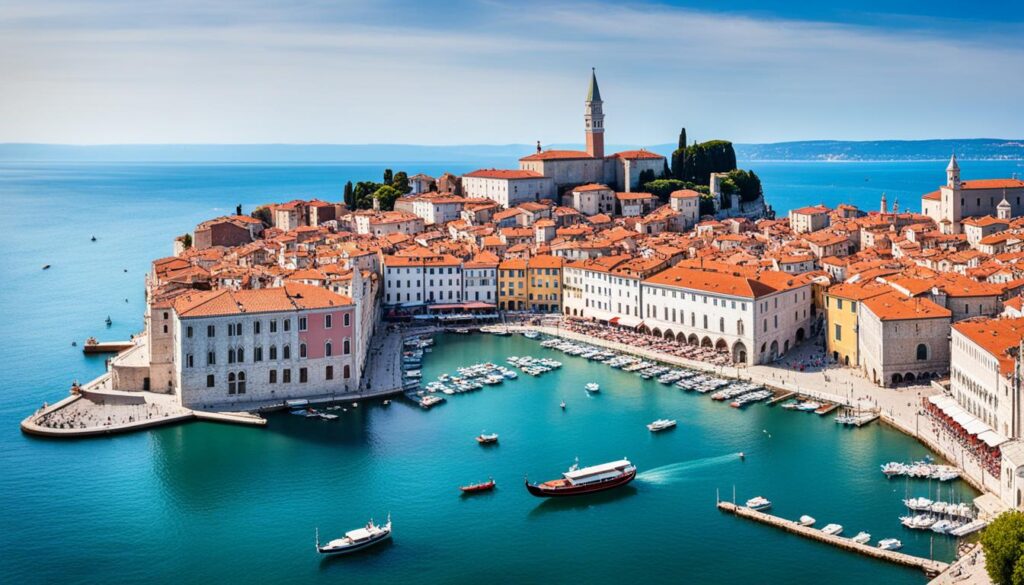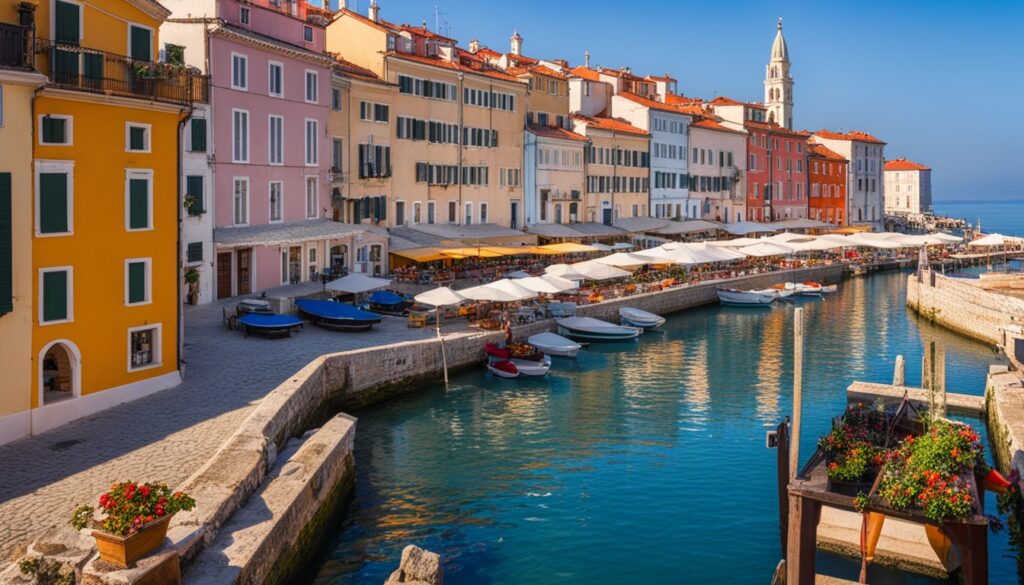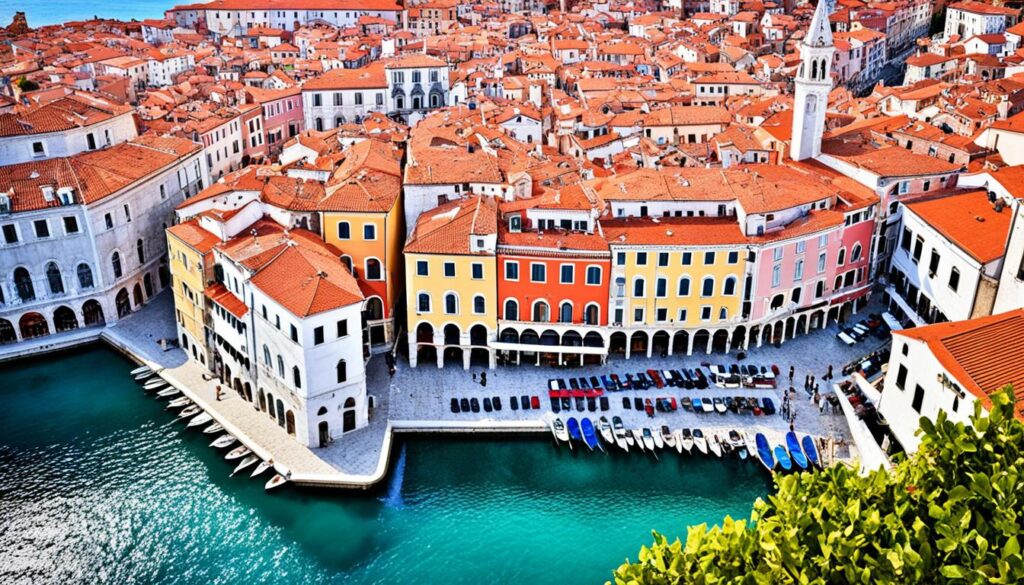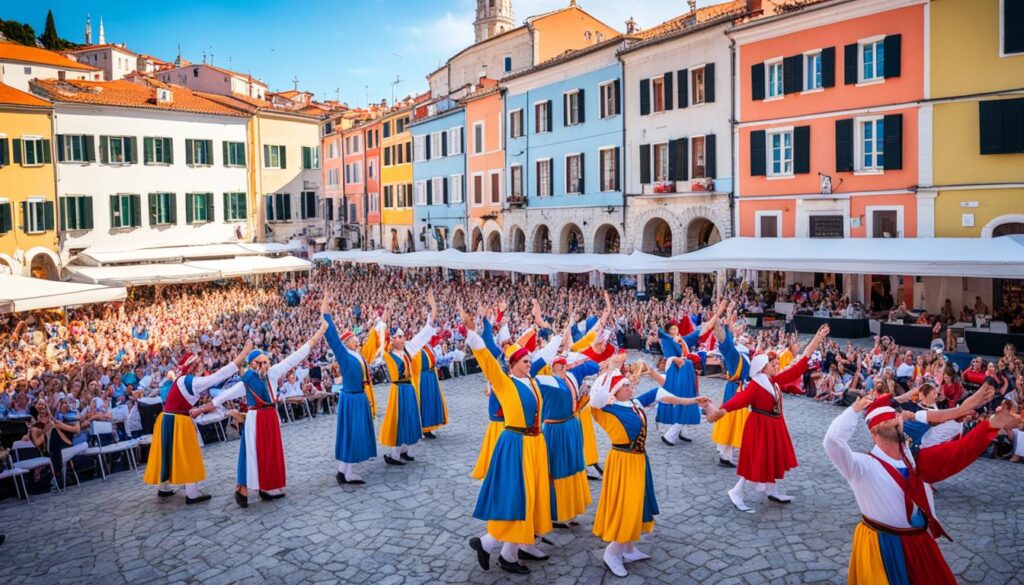Have you ever wondered about the secrets concealed in Piran’s scenic coastal town? What stories hide behind its lovely mask? Embark on a journey to the past with us. We’ll unveil the ancient origins and intriguing historical background of Piran, turning it into the charming spot it is today.
Piran started small but soon became a key maritime hub. Many critical events shaped its identity and culture. Discover a world of cultural rebirth, stunning architecture, and rich customs. It’s a must-visit for those who love history and exploring.
Ancient Origins of Piran
Discover Piran’s ancient beginnings. It’s a town rich in history and culture. It was founded long ago as a settlement. By learning about its past, we understand how this beautiful town was formed.
The story starts in prehistoric times. People settled here because of the land’s rich resources. Its location by the sea was also key.
Piran was always at the heart of different cultures and trade. Greek, Roman, and other influences shaped the town. Today, traces of these times can still be found.
Over time, Piran grew into a busy coastal hub. It became known for its trade across the Mediterranean. This success brought wealth and people from all around.
The town’s deep cultural history is still vibrant today. Its past has left a mark on everything, from its buildings to its way of life. Learning about Piran’s past shows us how important this history is to its people.
Exploring Piran’s beginnings lets us understand its present culture. The town cherishes its heritage. It’s an open invitation for everyone to step into its fascinating story.
Early Settlement and Influences
Piran’s early settlement is key to its historical and cultural importance. It stands near the Adriatic Sea, its history filled with many influences. These have all merged to define the town over time.
The story of Piran goes back to ancient times when it was first settled. It was a key spot for trade, linking many civilizations. This helped in sharing cultural ideas.
What makes Piran special is the mix of many cultures that influenced its look, customs, and life. The Greeks, Romans, Venetians, and Austro-Hungarians all added to its charm.
“Piran shows us how beautiful cultural mixes can be. Its rich history shows how civilizations worked together and created a unique style and culture.”
Piran became a place where various cultures came together. Moreover, the Venetian Republic greatly impacted its growth. It added to its sea activities, trades, and even how buildings were designed.
“Thanks to the Venetians, Piran now has beautiful buildings and streets. They remind us of a special time in its history.”
The town’s location put it in the path of big historical moments. It faced danger from the Ottoman Empire and changed to Habsburg rule. These changed its society and culture a lot.
“The Ottoman and then Habsburg times really shaped Piran. Their impact is still visible in how the town looks and how people live.”
In the end, Piran’s early history and the mix of cultures are what make it special. Knowing the past helps us value the present and keep Piran’s diverse heritage alive.
| Cultural Influences | Historical Significance |
|---|---|
| Greek | Contributed to early trade and cultural exchanges in Piran. |
| Roman | Established the foundations of the town’s urban planning and infrastructure. |
| Venetian | Shaped Piran’s maritime power, trade routes, and architectural style. |
| Ottoman Empire | Posed threats to Piran, influencing its political landscape and defense strategies. |
| Habsburg Empire | Imposed rule and brought forth cultural influences in Piran. |
Venetian Rule and Maritime Power
During the Venetian rule in Piran, the town’s maritime power grew. The Venetians were experts in the sea. They made Piran a crucial port and trade center in the Adriatic Sea. This time was key in Piran’s growth and made a big mark on its history.
Piran’s trade linked it to cities like Venice, Trieste, and Dubrovnik. This made it a vital hub for sea commerce. It welcomed the sharing of goods and ideas between many cultures.
The Venetians built strong defenses for Piran. They made mighty walls and ramparts that are still here today. These fortifications kept the town safe and its sea trade prosperous.
Naval Battles and Piracy
With its rising sea power, Piran saw some troubles as well. There were fights at sea with other states, as the Venetians fought hard for their interests.
Piracy was also a big problem. Pirates attacked both ships and towns along the Adriatic. But the Venetians did a lot to fight piracy, keeping the seas and trade routes safe.
Piran’s sea strength under Venetian rule made it a main hub in the Adriatic. It connected many areas and boosted the town’s wealth.
Architectural Influences
Piran’s look was changed by the Venetians’ architecture. The town’s buildings still show Venetian Gothic and Renaissance styles. They are full of fancy details, beautiful arches, and classic charm.
Tartini Square is a great example. It honors Giuseppe Tartini, Piran’s famous violinist. The square’s colorful buildings are a sign of Piran’s special architecture.
The Church of St. George is also special. Sitting on a hill, it overlooks the town. Its tower, inspired by Venice, lets you see Piran’s coastal beauty.
| Architectural Influences During Venetian Rule | Key Features |
|---|---|
| Venetian Gothic | Elegant arches, intricate stone carvings |
| Renaissance | Refined symmetry, classical elements |
| Venetian colors | Bright hues, pastel facades |
Explore Piran’s old streets and paths to see the beauty the Venetians left. Every part of town has a story from its rich past.
Ottoman Threats and Habsburg Rule
Piran faced big challenges in its history. It dealt with fears from the Ottoman Empire and later, a change to Habsburg control. These times were turning points for the town’s growth and cultural identity.
Ottoman Threats
Piran was under serious threat from the Ottomans during the 15th and 16th centuries. The town’s key location and thriving sea trade caught the Ottomans’ eye. They wanted to spread their reach in the area. In response, Piran’s people armoured their city with walls, defensive towers, and a dedicated defense force against possible attacks. *Amazingly, Piran stayed free and kept its own culture, with all these dangers.*
Shift to Habsburg Rule
In the early 19th century, Piran saw a big change in leadership, going to the Habsburg Empire. The Habsburgs were a mighty dynasty in Europe. They brought peace and steps forward to Piran, starting a new chapter for the town.
With Habsburg leadership came better streets, public areas, and changes to the city’s look, matching the trends of the time. The empire also placed a big bet on culture, by supporting education and art.
“The Habsburgs played a central role in shaping Piran’s cultural heritage. Their patronage of the arts and promotion of intellectual pursuits led to a flourishing artistic community and a vibrant cultural scene in the town.”
This time period made Piran a lively mix of different influences. The town shows how well it took from its past and added the Habsburg touch to its buildings, food, and ways.
| Impact of Ottoman Threats and Habsburg Rule on Piran | Ottoman Threats | Habsburg Rule |
|---|---|---|
| Economic Disruption | Trade routes disrupted, piracy threats | Modernization, stable economy |
| Architectural Influences | Defensive fortifications | Urban planning, Habsburg architectural style |
| Cultural Development | Preservation of cultural identity | Promotion of arts and intellectual pursuits |
| Social Dynamics | Heightened sense of community and self-defense | Rise in education and cultural diversity |
The mix of Ottoman threats and Habsburg rule made Piran special. The town keeps its early story while reflecting many cultural moments from its past.
Cultural Renaissance and Artistic Contribution
In Piran, a cultural renaissance led to a burst of art and creativity. The town saw many artists, musicians, and writers. These people greatly influenced Piran’s art scene at that time.
Giovanni Bellini, a famous painter, was one of them. He was born in Venice but his work also left a big impact in Piran. His choice of colors and how he put paintings together still inspires many today.
“Art speaks where words are unable to explain.” – Giovanni Bellini
Piran’s renaissance was not just about art. It also became a hotspot for classical music. Antonio Vivaldi, a celebrated composer, brought his beautiful music to the town. His pieces could be heard all around, delighting everyone.
Then there were the writers, like Giuseppe Tartini. He wrote poems and stories that told Piran’s tale. Through their words, the writers showcased what made the town special. They helped keep Piran’s beauty alive in literature.
The Cultural Legacy of Piran
The impact of Piran’s cultural revival can still be seen today. The town is full of art galleries and music events. These places attract many visitors who love art and music.
Piran remains a place where arts flourish. It encourages new talents with workshops and programs. It’s a supportive town for anyone in the arts.
| Artists | Medium | Notable Works |
|---|---|---|
| Giovanni Bellini | Painting | Madonna and Child |
| Antonio Vivaldi | Music | The Four Seasons |
| Giuseppe Tartini | Literature | Sonata in G minor, “The Devil’s Trill” |
Piran’s creative spirit continues to thrive. Thanks to its rich history, the town is a perfect space for artists. It’s a place where creativity is deeply cherished and encouraged.
World War II and Socialist Era
Let’s dive into how World War II and the socialist era changed Piran. These times had a big impact on the town. They influenced its growth, look, and how people lived there.
Piran went through a lot during World War II, just like other places on the coast. It was under Italian control and was important because it’s close to the Adriatic Sea.
The town was heavily bombed. It suffered from both sides fighting. The war damage changed the town and its people forever. Yet, they stood strong, facing the hard times of being occupied and not knowing what would happen next.
After the war, Piran became part of Yugoslavia. It was a time when the town’s life was changing fast under socialism. Things like how it was run, its economy and social order were all new.
Piran was modernized and industrialized during the socialist years. New homes were built, the town was improved, and factories were set up. This aimed to make Piran a modern place following socialist ideas.
“The socialist era in Piran represented an era of transition, rebuilding, and striving towards a new future. The town’s landscape transformed as new buildings, both residential and industrial, emerged.”
Even with these big changes, Piran kept its unique and historic feel. Its architecture still shows off beautiful past styles like Venetian and Gothic. You can still see these influences today.
The town also focused more on culture under socialism. Local art and traditional performances were supported. Theaters and museums were built to help people remember and celebrate Piran’s history.
Over time, Piran started to be known as a place for tourists. Its history and pretty coast draw many visitors today.
Architectural Transformations during the Socialist Era
The time of socialism in Piran changed its architecture a lot. The buildings that went up then showed the ideas of that time. They were simple, but very functional.
An example of this is the Tartini Hotel, once known as the Portorož Hotel. This interesting building shows the style of that period. It’s a symbol of how Piran evolved.
Modern Era and Tourism Boom
In the modern era, Piran saw a big change thanks to a boom in tourism. The town’s historical tales and beautiful coast attracted travelers worldwide.
Piran appealed to many with its old charm, impressive architecture, and lively culture. It had a special mix of influences that visitors loved. Wandering through its streets meant diving into its past and feeling its unique vibe.
“Piran truly offers a glimpse into the past, with its well-preserved architecture and captivating stories from centuries gone by. It’s a place where history comes to life, leaving a lasting impression on all who visit.”
This change made Piran a top spot for tourists. It boosted the town’s economy, making local businesses grow. They offered visitors real experiences, great food, and special souvenirs.
Today, Piran is still a lively coastal town that lovers of history, culture, and nature flock to. The tourism industry is key for the town, keeping its historical stories alive for future visitors.
| Key Highlights: | Attractions: |
|---|---|
|
|
Architectural Heritage in Piran
Piran’s buildings tell stories of its long history. They mix Venetian, Gothic, and Renaissance styles in a unique way. When you walk through its streets, every building seems to have its own story to tell.
The town clearly shows its link to Venetian architecture. You’ll see this in everything from the detailed facades to the famous Church of St. George’s bell tower. This style highlights the Venetian Republic’s strong influence in Piran, showing off its cultural and historical value.
“Piran’s architecture is a living testament to the town’s historical past, with each building telling its own story of centuries past.” – Architectural historian
The impact of Gothic design can be seen in places like the Town Walls and the Venetian House. The Town Walls stand tall, offering great views. The Venetian House, with its Gothic features, gives us a peek into Piran’s past, steeped in the Middle Ages.
Renaissance style also contributes to Piran’s beauty. Tartini Square, named after a famous musician, shows off Renaissance elegance. It’s decorated with facades, porticoes, and a statue of Giuseppe Tartini, making it a great place to explore.
As you walk by the sea or go through the town’s alleys, Piran’s history is all around you. It’s a chance to witness the town’s special architectural mix of Venetian, Gothic, and Renaissance. Each style has its own story, adding to Piran’s unique and lovely atmosphere.
Piran’s Cultural Festivals and Traditions
Dive into Piran’s exciting cultural life with its festivals and customs. These events honor Piran’s history and offer a unique time for all. They show a fascinating insight into the town’s past.
Piran Summer Music
Piran Summer Music is a top festival. It happens every summer, featuring various songs. From classical to jazz to traditional music, it fills Piran’s streets with beautiful sounds. Everyone enjoys the music in Piran’s lovely setting.
Piran Tartini Festival
The Piran Tartini Festival celebrates Giuseppe Tartini, Piran’s famous composer. It features classical music by top artists from all over. You’ll feel the beauty of Tartini’s music in the town he loved.
Festa Panoráma
Festa Panoráma shows Piran’s cultural mix. It combines music, dance, and food from different times and places. Eat tasty local food, watch dances, and enjoy the festival’s spirit.
Carnival of Piran
The Carnival of Piran is a fun, colorful event. People wear bright costumes and masks. They walk the streets, have fun, and keep old traditions alive. It’s a joyful time for all.
| Event | Date | Description |
|---|---|---|
| Piran Summer Music | July – August | A festival that celebrates a diverse range of musical performances, including classical, jazz, and traditional folk music. |
| Piran Tartini Festival | September – October | A festival dedicated to composer Giuseppe Tartini, featuring classical music concerts and recitals. |
| Festa Panoráma | August | A festival showcasing the cultural diversity and heritage of Piran through music, dance, and gastronomy. |
| Carnival of Piran | February | A lively event where participants dress up in costumes and masks, parading through the streets and celebrating with music and dance. |
Piran has many more festivals and traditions that show its energy and charm. By joining these events, you will learn and love Piran’s history and culture. Be sure to look at the festival times when you plan your visit to Piran. You won’t want to miss these celebrations.
Historical Landmarks and Points of Interest
Exploring Piran means finding lots of historical sites. These places mark the town’s deep history and culture. They show how different things over the years shaped Piran. You’ll see old squares and churches, each with its own story about Piran.
Tartini Square
The famous Tartini Square in Piran is named after Giuseppe Tartini. He was a big violinist and composer born in the town. This square is at the center of life, filled with cafes and beautiful buildings. It shows off a lot of Venetian-style charm, including a statue of Tartini.
Church of St. George
The Church of St. George is high above the town, showing its spiritual side. This medieval church has amazing views of the Adriatic Sea and Piran. Inside, you can see lovely frescoes, old relics, and feel a peaceful atmosphere.
Piran City Walls
Piran’s old city walls are a walk into history. They offer great sea and town views as you stroll. You’ll see big watchtowers and gates that once kept the town safe from the sea.
St. Clement’s Church
St. Clement’s is a medieval gem hiding in the town’s alleys. Its facade is decorated beautifully. Inside, a gorgeous vaulted ceiling, old wooden pews, and colorful glass windows await.
In Piran, history is everywhere. You can feel the rich stories just by looking at the old buildings. These landmarks reflect Piran’s lasting charm and cultural value, attracting anyone interested in its past.
Conclusion
As we finish our journey through Piran’s rich history, we’re amazed by its many influences. These influences range from ancient times to the Venetian era, Ottoman threats, and a cultural rebirth. It’s a clear example of how historical events have shaped this lovely coastal town.
It’s vital to keep Piran’s history and culture alive. By protecting its buildings, hosting cultural events, and keeping traditions, we ensure it remains charming. This way, the upcoming generations can know and love Piran as we do.
Walking the town’s narrow streets, seeing the sights, or joining its lively festivals helps you connect with its past. Piran isn’t just a pretty town by the sea. It’s a place where the stories and achievements of its people are still felt today.




























